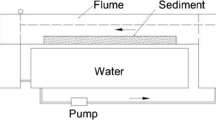Abstract
This study aimed to optimise the methodology for the use of Corophium insidiosum in a bioassay. Taking into account that it would be suitable to execute the bioassay with organisms having a good sensitivity during the year and low mortality in control sediment, the influence of different temperatures (10–15–20 and 25°C) has been examined. C. insidiosum was collected during August, November 2005 and January 2006, in Mar Piccolo basin (Ionian sea). The results obtained show that this species mortality in the negative control sediment, ranged from 2.6 ± 0.6% at 10°C in August to 17 ± 2.2% at 20°C in November, at different temperatures tested. At 20°C there were significant differences in mortality among different months examined. Indeed no relationship among months was found at 15°C. Significant differences between August and November at 25°C, between November and January were not found at 10°C. The 96-h LC50 values found for cadmium at all temperature experimental conditions ranged from 2.11 mg/l (1.57–2.82) to 0.70 mg/l (0.54–0.93). The highest values were found at 10°C in November and January. The results showed that the optimal temperature for the bioassay seems to be between 15°C and 20°C. Even if, at 20°C the mortality differs significantly among organisms sampled.
Similar content being viewed by others
References
Anger, K. (1979). Intersuchungen zum Lebenszyklus der Amphipoden Bathyporeia sarsi, Microdeutopus gryllotalpa, und Corophium insidiosum in der Kieler Bucht. Mitteilungen aus dem Zoologischen Museum. Kiel, 1(3), 1–6.
ASTM (1990). Standard guide for conducting 10-day static sediment toxicity test with marine and estuarine amphipods. ASTM E 1367-90. American Society for testing and Materials. Philadelphia. PA. pp. 1–24.
ASTM (1993). Standard guide for conducting 10-d static sediment toxicity tests with marine and estuarine amphipods. In Annual book of ASTM standards, water and environmental technology 11.04, E1367-92. Philadelphia: ASTM.
ASTM (1997). Standard guide for conducting 10-d static sediment toxicity tests with marine and estuarine amphipods. In Annual book of ASTM standards, water and environmental technology. 11.05, E1367-92 (pp. 731–756). Philadelphia, PA: ASTM.
Bigongiari, N., Braida, T., Carretti, F., & Pellegrini, D. (2004). Influence of temperature on the mortality and sensitivity of Corophium orientale. Bulletin of Environmental Contamination and Toxicology, 72, 881–887.
Buccolieri, A., Buccolieri, G., Cardellicchio, N., Dell’Atti, A., Di Leo, A., Maci, A., et al. (2004). Distribution and speciation of metals in surface sediments of Taranto gulf (Ionian sea, Southern Italy). Annali di Chimica, 94(7–8), 469–478.
Cossins, A. R., & Bowler, K. (1987). Temperature biology of animals. New York: Chapman & Hall.
Costa, O. F., & Costa, M. H. (2000). Review of the ecology of Gammarus locusta (L.). Polskie Archiwum Hydrobiologii, 47, 541–559.
Crawford, G. I. (1937). A review of the amphipod genus Corophium with notes on the British species. Journal of Marine and Biological Association, UK, 21, 589–630.
Davies, P. S., & Tribe, M. A. (1969). Temperature dependence of metabolic rate in animals. Nature, 224, 723–724.
de Casabianca, M. L. (1967). Sur la biologie de Corophium insidiosum Crawford dans l’étang de Biguglia (Corse). Bulletin of the Zoological Society of France, 91, 401–405.
de Casabianca, M. L. (1968). Sur le cycle annuel des populations de Corophium insidium [i.e. insidiosum] Crawford dans l’étang de Biguglia (Corse), et ses variations dans des conditions exceptionnelles. Vie et Milieu. Serie A, Biologie Marine, 19, 159–164.
Hamilton, M. A., Russo, R. C., & Thurston, R. V. (1977). Trimmed Spearman-Karber method for estimating median lethal concentrations in toxicity bioassays. Environmental Science & Technology, 11, 714–719.
Hong, J. S., & Reish, D. J. (1987). Acute toxicity of cadmium to eight species of marine amphipod and isopod crustaceans from Southern California. Bulletin of Environmental Contamination and Toxicology, 39, 884–888.
ISO (2005). Water quality – Determination of Acute toxicity of marine and estuarine sediments to amphipods. ISO/CD 16712:2005(E). First Edition. TC 147/SC5/WG2, p16.
Krapp-Schickel, G. (1971). Meereresamphipoden aus Taranto. Memorie del Museo Civico di Storia Naturale di Verona, 18, 343–367.
Lee, D. R. (1980). Reference toxicants in quality control of aquatic bioassays. In A. L. Builkema & J. Cairns Jr. (Eds.), Aquatic invertebrate bioassays (pp. 715). Philadelphia, PA: ASTM STP.
Lee, W. Y. (1977). Some laboratory cultured crustaceans for marine pollution studies. Marine Pollution Bulletin, 8, 258–259.
Lydy, M. J., Belden, J. B., & Ternes, M. A. (1999). Effects of temperature on toxicity of m-parathion, chlorpyrifos, and Pentachlorobenzene to Chironomus tentans. Archives of Environmental Contamination and Toxicology, 37, 542–547.
Nugegoda, D., & Rainbow, P. S. (1987). The effect of temperature on zinc regulation by the decapod crustacean Palemon elegans Rathke. Ophelia, 27, 17–30.
Reish, D. J. (1993). Effects of metals and organic compounds on survival and bioaccumulation in two species of marine gammaridean amphipod, together with a summary of toxicological research on this group. Journal of Natural History, 27, 781–794.
Schellemberg, A. (1942). Flohkrebse oder Amphipoden. Tierwelt Dtl, 40, 1–252.
SETAC-Europe (1993). Guidance document on sediment toxicity assessment for freshwater and marine environments. In I. R. Hill, P. Matthiessen & F. Heinbach (Eds.), Workshop on sediment toxicity assessment. Netherlands: Setac-Europe.
U.S. EPA (1995). Short-term methods for estimating chronic effluents and receiving waters to west coast marine and estuarine organisms. USEPA, 600/R-95/136, Cincinnati, Ohio.
Author information
Authors and Affiliations
Corresponding author
Rights and permissions
About this article
Cite this article
Prato, E., Scardicchio, C. & Biandolino, F. Effects of temperature on the acute toxicity of cadmium to Corophium Insidiosum . Environ Monit Assess 136, 161–166 (2008). https://doi.org/10.1007/s10661-007-9672-8
Received:
Accepted:
Published:
Issue Date:
DOI: https://doi.org/10.1007/s10661-007-9672-8




